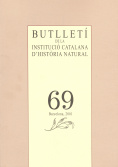Un endemisme ornitològic ignorat: el trencapinyons balear (Loxia balearica)
Article Sidebar

Main Article Content
Cristian R. Altaba
Crossbills (genus Loxia) are one of the least known groups of extratropical birds. Their diversification has been associated with the large changes suffered throughout the Pleistocene by the boreal forests in which they live. In the Balearics there is a sedentary population in Mallorca, and their occasional presence on the other islands seems due to the arrival of birds sporadically irrupting into western Europe and the Mediterranean. Resident crossbills are distinguished by their small body size; shorter, thicker, and more arched bill, with a shorter lower mandible; comparatively shorter wings; and paler, greyer plumage. They have maintained their identity since the upper Pleistocene at least, indicating reproductive isolation from their continental congener, from which they exhibit fixed genetic differences. Their divergent morphology can be interpreted as an adaptation to the exploitation of pine woods with an irregular food yield in insular conditions. The evidence from morphometrics, palaeontology, molecular genetics, ecology and biogeography indicates that this is an endemic species: Loxia balearica (Homeyer, 1862). The Balearic crossbill is a species deserving closer study, and perhaps priority conservation measures. Its recognition as a distinct species, together with what has been done for the Balearic shearwater, implies that the Balearics are an endemic bird area of global importance, unique in western Europe.
Article Details
How to Cite
Altaba, Cristian R. “Un endemisme ornitològic ignorat: el trencapinyons balear (Loxia balearica)”. Butlletí de la Institució Catalana d’Història Natural, pp. 77-90, https://raco.cat/index.php/ButlletiICHN/article/view/163695.
Most read articles by the same author(s)
- Cristian R. Altaba, Albert Orozco i Sanchís, Anna Traveset, Jordi Cadevall, Cargols d'aigua dolça exòtics a Barcelona , Butlletí de la Institució Catalana d'Història Natural: 1988: 55 : 1988 (Secció de Zoologia, 7)
- Cristian R. Altaba, La Distribució geogràfica i ecològica dels bivalves d'aigua dolça recents dels Països Catalans , Butlletí de la Institució Catalana d'Història Natural: 1992: 60 : 1992 (Secció de Zoologia, 9)
- Cristian R. Altaba, Els Esferíids (Mollusca: Bivalvia: Sphaeriidae) dels Països Catalans , Butlletí de la Institució Catalana d'Història Natural: 1992: 60 : 1992 (Secció de Zoologia, 9)
- Cristian R. Altaba, Les Nàiades (Mollusca: Bivalvia: Unionoida) dels Països Catalans , Butlletí de la Institució Catalana d'Història Natural: 1992: 60 : 1992 (Secció de Zoologia, 9)
- Cristian R. Altaba, Anna Traveset, La Malacologia als Països Catalans , Butlletí de la Institució Catalana d'Història Natural: 50 : 1984 : Commemoratiu
- Cristian R. Altaba, Anna Traveset, Noves localitzacions d'Opistobranquis als Països Catalans , Butlletí de la Institució Catalana d'Història Natural: 52 : 1985 (Secció de Zoologia, 6)
- Cristian R. Altaba, Introducció a l'estudi dels mol·luscs dels aiguamolls de l'Alt Empordà , Butlletí de la Institució Catalana d'Història Natural: 1980: 45 : 1980 (Secció de Zoologia, 3)
- Cristian R. Altaba, Al Límit de l'extinció: Margaritifera auricularia (Bivalvia: Unionoida) , Butlletí de la Institució Catalana d'Història Natural: 1997: 65 : 1997
- Cristian R. Altaba, Josep Lascurain i Golferichs, Una població supervivent del gènere Anodonta (Bivalvia: Unionoida) a la conca de la Tordera , Butlletí de la Institució Catalana d'Història Natural: 69 : 2001